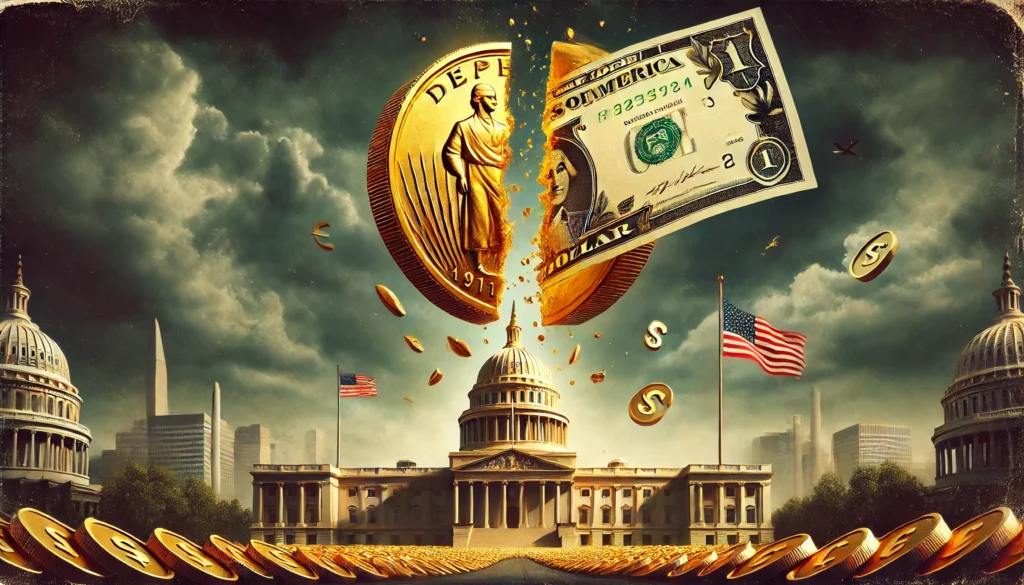

Introduction
The gold standard was once the foundation of the global financial system, ensuring monetary stability and fostering international trade. However, despite its advantages, it ultimately collapsed, giving way to the modern fiat currency system. What led to its rise? Why did it fail? And could the world ever return to a gold-backed economy? In this article, we’ll explore the history, advantages, and downfall of the gold standard, as well as its impact on today’s economy.
1. What Is the Gold Standard?
The gold standard is a monetary system where a country’s currency is directly linked to a specific quantity of gold. Under this system:
- Governments set a fixed price for gold and exchange paper currency for gold at that rate.
- A country’s gold reserves limit the supply of money.
- International trade benefits from stable exchange rates as currencies are backed by tangible assets.
This system provided economic stability by preventing governments from printing unlimited money, thus controlling inflation. Nevertheless, it also had drawbacks that would eventually lead to its demise.
Sources:
📌Investopedia – What is the Gold Standard?
📌 Reserve – History of the Gold Standard in the U.S.
📌World Gold Council – The Role of Gold in Monetary Systems
2. The Birth of the Gold Standard

The first country to formally adopt the gold standard was the United Kingdom in 1821. By the late 19th century, many major economies including the United States, Germany, and France had also linked their currencies to gold. As a result, international trade became more stable and predictable.
Key reasons for its widespread adoption:
- It provided stability and trust in international trade.
- It controlled inflation by limiting money supply expansion.
- It prevented governments from reckless spending since money supply was constrained by gold reserves.
During this period, global economies flourished under what became known as the Classical Gold Standard Era (1870-1914).
Sources:
📌Bank of England – The UK’s Transition to the Gold Standard
📌U.S. Treasury – The U.S. Gold Standard Adoption History
3. The Golden Age: How the Gold Standard Supported Economic Growth
The late 19th and early 20th centuries were marked by strong economic growth, facilitated by:
- Fixed exchange rates, which reduced currency fluctuations and encouraged trade.
- Confidence in paper money, as people knew it could be exchanged for gold.
- Lower inflation rates, due to money supply constraints.
Countries adhering to the gold standard experienced unprecedented stability in financial markets. This system played a crucial role in financing industrial revolutions and international commerce.
Sources:
📌IMF – Why the Gold Standard Failed
📌Bretton Woods Agreement (U.S. Department of State Archives)
📌Library of Congress – Nixon and the End of the Gold Standard
📌Federal Reserve Bank – The Nixon Shock and Its Economic Impact
4. The Cracks Begin to Show: Challenges of the Gold Standard
Despite its benefits, the gold standard had inherent weaknesses:
- Gold Supply Constraints: If a country ran out of gold reserves, it couldn’t expand its money supply, leading to economic stagnation.
- Lack of Monetary Flexibility: Governments couldn’t print more money during economic crises, worsening recessions.
- Uneven Gold Distribution: Some countries had vast gold reserves, while others struggled to acquire enough, leading to financial imbalances.
- Economic Dependence on Gold Production: Nations were forced to mine or import gold to sustain their economies.
These limitations became painfully evident during economic crises, most notably the Great Depression.
Sources:
📌World Economic Forum – How the End of the Gold Standard Changed the Economy
📌The Balance – Fiat Money vs. Gold Standard
5. The Great Depression and the Collapse of the Gold Standard
The 1929 stock market crash triggered the Great Depression, plunging the global economy into chaos. Governments needed to inject liquidity to revive economies but unfortunately, the gold standard restricted their ability to do so.
- The U.K. abandoned the gold standard in 1931 to regain control over its economy.
- The U.S. suspended gold convertibility in 1933 under President Franklin D. Roosevelt’s New Deal policies.
- The final blow came in 1944 with the Bretton Woods Agreement, which established a new financial system where the U.S. dollar, rather than gold, became the world’s reserve currency.
Sources:
📌 Forbes – Why Some Economists Want to Return to the Gold Standard
📌 Bitcoin vs. Gold Standard – Can Cryptocurrencies Replace Gold?
6. The Official End: Nixon and the 1971 Gold Shock

While the gold standard was effectively weakened after the Great Depression, the U.S. still backed its currency with gold until President Richard Nixon officially ended gold convertibility in 1971. This move:
- Allowed the U.S. government to print more money without gold reserves.
- Shifted the global financial system to fiat currency, where money has value by government decree rather than gold backing.
- Marked the beginning of floating exchange rates, where currency values fluctuate based on market conditions.
This event, known as the Nixon Shock, completed the transition to today’s modern monetary system.
7. The Impact of the Gold Standard’s Demise on Today’s Economy
The shift from gold-backed money to fiat currency introduced new economic dynamics:
✅ Pros:
- Greater monetary flexibility for governments to manage economic crises.
- Ability to control inflation and unemployment more effectively.
- Encouragement of economic growth through controlled money expansion.
❌ Cons:
- Increased debt accumulation, as there are no constraints on money printing.
- Higher inflation risks, since fiat currencies are not backed by physical assets.
- Financial instability due to floating exchange rates.
While fiat currency systems have fueled economic expansion, they have also contributed to major financial crises, such as the 2008 global recession.
8. Could the World Return to the Gold Standard?
The Gold Standard rised on the surface as many economists argue that a return to the gold standard is unlikely due to:
- The insufficient global gold supply to back the modern economy.
- The high cost of maintaining gold reserves.
- The economic rigidity it would impose on governments.
However, some advocates propose alternative solutions, such as:
- Gold-backed cryptocurrencies to combine gold’s stability with digital innovation.
- Hybrid monetary systems, where some value is linked to commodities like gold.
While these ideas are intriguing, they remain theoretical, and the global economy continues to operate under a fiat currency system.
Conclusion
The gold standard played a crucial role in shaping modern economies, providing stability and trust in financial transactions. However, its limitations ultimately led to its downfall, giving rise to today’s fiat currency system.
The question remains: Did abandoning the gold standard create more financial instability than it solved? As inflation and debt continue to rise, some argue that the world may one day seek an alternative to fiat money. But for now, the era of gold-backed currencies remains a chapter in economic history.
Read Also:
The Economic Inflation: All What You Must Know



